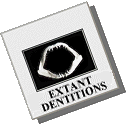| |
Extant wobbegongs (three genera) are sometimes large (0.5-3.8m) warm/tropical water bottom-dwelling sharks of Australia and the Western Pacific. Ranging from intertidal to 100m+ waters; they feed on fish, crustaceans and cephalopods.
 The dentition may be viewed as clutching in design with monognathic heterodonty. Each quadrate has two or three tall, well-spaced fang-like teeth anteriorly; laterals & posteriors number 10-12 and display more gradational heterodonty (closely spaced with shorter cusps distally). The teeth are best characterized by the cusp's apron which extends well over the root. the low extended shoulders and hemiaulacorhizous (closed) or holaulacorhizous (open nutrient groove) roots. [Refer to slideshow or Herman et al 1992.]
The dentition may be viewed as clutching in design with monognathic heterodonty. Each quadrate has two or three tall, well-spaced fang-like teeth anteriorly; laterals & posteriors number 10-12 and display more gradational heterodonty (closely spaced with shorter cusps distally). The teeth are best characterized by the cusp's apron which extends well over the root. the low extended shoulders and hemiaulacorhizous (closed) or holaulacorhizous (open nutrient groove) roots. [Refer to slideshow or Herman et al 1992.]
Case (1978) erected two orectolobid species for teeth from the upper Judith River Fm (Late Campanian) of Montana (US) -- Cretorectolobus olsoni and Eucrossorhinus microcuspidatus. After collecting and studying this fauna, Siverson (1995) argued that E. microcuspidatus represented juvenile C. olsoni teeth and that two distinct genera were present in Case's specimen-suite; using Case's paratype, Siverson erected Cederstroemia for the second tooth-design; he would go on to describe two species for this new genus, Cederstroemia triangulata (lCamp, US) and C. nilsi (eCamp, Sweden).
Cederstroemia teeth were characterized by their
small but robust teeth (high as wide in anterior positions),
short cusp,
oblique shoulders,
lack of cusplets,
well-developed apron (labial),
uvula (lingual) flattened medially, and
thick root (hol- or hemiaulacorhizous).
Both of Siverson's taxa have Squatina-like crowns, but are differentiated from Squatina by the apron which reaches the base of the root and the root-design; Squatina roots are hemiaulacorhizous while Cretorectolobus/Cederstroemia may be holaulacorhizodus. Cederstroemia differs from Cretorectolobus on the basis of a more cutting-like design, thicker crown, oblique shoulders and a complete lack of cusplets.
Siverson noted that the Cederstroemia tooth-design had been previously reported by:
Reuss (1846 pl 21, fig 18) as Squatina muelleri (Turonian, Bohemia)
Case (1978 pl 2.2, text fig. 9.a-c) as Cretorectolobus olsoni (Campanian, Montana)
Cappetta (1987 fig 68.a-c) as Cretorectolobus olsoni (Campanian, Montana)
Williamson et al (1989 fig 3.f,g) as Squatina sp (Santonian, NM)
Landemain (1991) as Cretorectolobus sp & C. cf mulleri (Albian-Cenomanian France)
Biddle (1993 pl 1.5,6) as Squatina mulleri & Cretorectolobus (Albian, France).
Wroblewski (2004) reported Cederstroemia (and Cretorectolobus) from the Ferris Fm (Maastrichtian portion) of southern Wyoming.
Bourdon et al (2011) erected Cederstroemia ziaensis for teeth from the Santonian of New Mexico which differed from both C. triangulata and C. nilsi.
Footnotes
| 1 | Siverson (1995:975) included as "Family incertae sedis" and noted that a distinct family would eventually be required. Based on general tooth-design (not dentition) the website is inclinded to use "? Orectolobidae" which provides a better comparative basis until a family is erected. |
Selected References
Biddle, J., 1993. Les elasmobranches de l'Albien inférieur et moyen (Crétacé inférieur) de la Marne et de la Haute-Marne (France). Belgian Geo. Survey. Professional Paper, 264:191-240.
Bourdon, J., Wright, K., Lucas, S.G., Spielmann, J.A. and Pence, R., 2011. Selachians from the Upper Cretaceous (Santonian) Hosta Tongue of the Point Lookout Sandstone, central New Mexico. New Mex. Mus. Nat. His. and Sc., Bulletin 52; 54pp.
Cappetta, H., 1987. Chondrichthyes II. Mesozoic and Cenozoic Elasmobranchii. In: Handbook of Paleoichthyologie, vol. 3b, Gustav Fischer Verleg, Stuttgart, 193 pp.
Case, G., 1978. A new selachian fauna from the Judith River Formation (Campanian) of Montana. Palaeontographica (A), 160:176-205.
Case, G., 1987. A new selachian fauna from the late Campanian of Wyoming (Teapot Sandstone Mbr., Mesaverde Fm., Big Horn Basin). Palaeotographca (A), 197:1-37.
Herman, J., M. Hovestadt-Euler, and D. C. Hovestadt., 1992. Contributions to the
study of the comparative morphology of teeth and other relevant ichthyodorulites in living
supraspecific taxa of chondrichthyan fishes.
Part A: Selachii. No 4:
Order: Orectolobiformes Families: Brachaeluridae, Ginglymostomatidae, Hemiscyllide, Orectolobidae, Parascylliidae, Rhinodontidae, Stegostomatidae
Order: Pristiophoriformes - Family: Pristiophoridae
Order: Squatiniformes - Family: Squatinidae
Bulletin de L'Institut Royal des Sciences Naturelles de Belgique, Biologie,62: 193-154.
Reuss, A., 1846. Die Versteinerungen der böhmishen Kreideformation. Zweite Abtheilung, Stuttgart, 148 p.
Siverson, M., 1995. Revision of Cretorectolobus (Neoselachii) and description of Cederstroemia n. gen., a Cretaceous caarpet shark (Orectolobiformes) with a cutting dentition., Journal of Paleontology, 69(5), pp 974-79.
Williamson, T., S. Lucas and R. Pence, 1989. Selachians from the Hosta Tongue of the Point Lookout Sandstone (Upper Cretaceous, Santonian) Central New Mexico. New Mexico Geological Society Guidebook, 40:239-245.
Wroblewski, A. 2004. New selachian paleofaunas from “Fluvial” deposits of the Ferris and Lower Hanna Formations (Maastrichtian-Selandian: 66-58 Ma), Southern Wyoming. Palaios 19(3): 249-258.
|